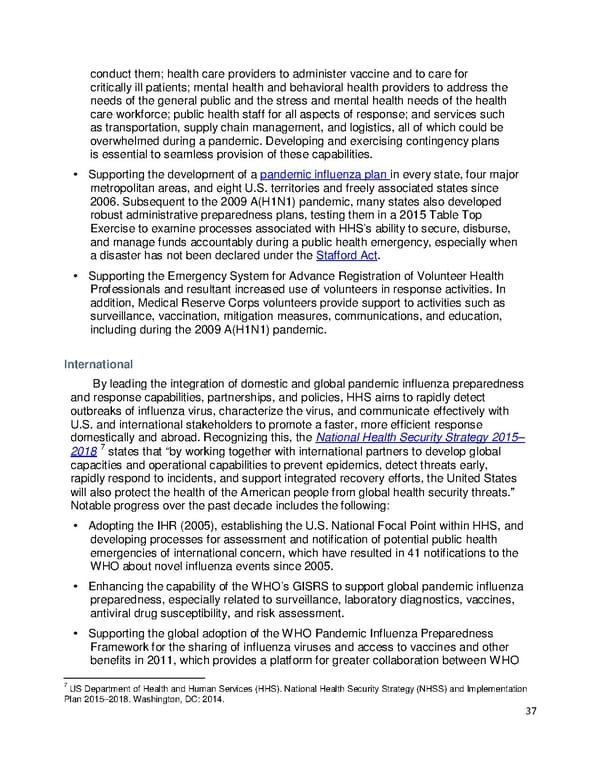conduct them; health care providers to administer vaccine and to care for critically ill patients; mental health and behavioral health providers to address the needs of the general public and the stress and mental health needs of the health care workforce; public health staff for all aspects of response; and services such as transportation, supply chain management, and logistics, all of which could be overwhelmed during a pandemic. Developing and exercising contingency plans is essential to seamless provision of these capabilities. • Supporting the development of a pandemic influenza plan in every state, four major metropolitan areas, and eight U.S. territories and freely associated states since 2006. Subsequent to the 2009 A(H1N1) pandemic, many states also developed robust administrative preparedness plans, testing them in a 2015 Table Top Exercise to examine processes associated with HHS’s ability to secure, disburse, and manage funds accountably during a public health emergency, especially when a disaster has not been declared under the Stafford Act. • Supporting the Emergency System for Advance Registration of Volunteer Health Professionals and resultant increased use of volunteers in response activities. In addition, Medical Reserve Corps volunteers provide support to activities such as surveillance, vaccination, mitigation measures, communications, and education, including during the 2009 A(H1N1) pandemic. International By leading the integration of domestic and global pandemic influenza preparedness and response capabilities, partnerships, and policies, HHS aims to rapidly detect outbreaks of influenza virus, characterize the virus, and communicate effectively with U.S. and international stakeholders to promote a faster, more efficient response domestically and abroad. Recognizing this, the National Health Security Strategy 2015– 2018 7 states that “by working together with international partners to develop global capacities and operational capabilities to prevent epidemics, detect threats early, rapidly respond to incidents, and support integrated recovery efforts, the United States will also protect the health of the American people from global health security threats.” Notable progress over the past decade includes the following: • Adopting the IHR (2005), establishing the U.S. National Focal Point within HHS, and developing processes for assessment and notification of potential public health emergencies of international concern, which have resulted in 41 notifications to the WHO about novel influenza events since 2005. • Enhancing the capability of the WHO’s GISRS to support global pandemic influenza preparedness, especially related to surveillance, laboratory diagnostics, vaccines, antiviral drug susceptibility, and risk assessment. • Supporting the global adoption of the WHO Pandemic Influenza Preparedness Framework for the sharing of influenza viruses and access to vaccines and other benefits in 2011, which provides a platform for greater collaboration between WHO 7 US Department of Health and Human Services (HHS). National Health Security Strategy (NHSS) and Implementation Plan 2015–2018. Washington, DC: 2014. 37
 Pandemic Influenza Plan Page 36 Page 38
Pandemic Influenza Plan Page 36 Page 38